Both battleships were very similar, in fact they were near-sister ships, built at New Admiralty and Nicolaiev yards. They were relatively small, and only differed in armament (see later), that’s why they are seen together here.
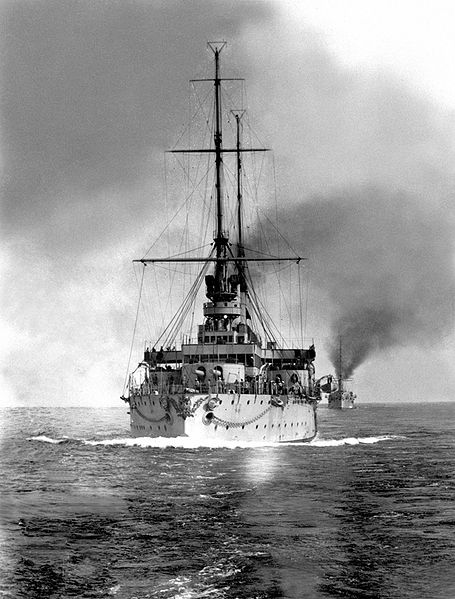
Rostislav with the black sea fleet
Sissoi Veliky
Contrary to past battleships like the Tri Svititelia and Navarin, she had as designed an higher freeboard, at 23 feets. She was a 10,400 ton ship, armed with pivot-type turrets and four 305 mm (12 in) as main armament. Her secondary armament consisted in a battery of six 152 mm in barbettes (6 in, 45 caliber), and her anti-TBs battery consisted in 12 x 3 pdr (47 mm) and 18 x 1-pdr (37 mm) and for close encounters, there were three 18 in (457 mm) torpedo tubes above the waterline, each side. The Sissoi Veliky was laid down in may 1892, launched in june 1894 and completed in 1896.
Her armour was made of nickel steel, her belt was up to 406 mm in the central section (4 to 16 in) thick, turrets 305 mm (12 in) overall, barbettes for the secondary guns were 127 mm (5 in), and the conning tower 203 mm (8 in) thick. Propulsion was assured by 12 bellevilles boilers steaming two Vertical Tubes engines producing 8500 ihp for 15.7 knots in top speed, and a reserve of 500 to 800 tons of coal.
Rostislav
The Rostislav was started in Nicolaiev in 1895 and completed in 1898, the Rostislav was the sister ship of Sissoi Veliky (1894). It differed from the first one, sunk at sushima, by a few details: It has a draft of less than a meter and a light armor. With comparable machines, it was not much faster. But the biggest difference with the Sissoi Veliky was its main armament, reduced to 234 mm instead of 305 mm guns, in French-type turrets. In addition her secondary battery was amidship on either beam.
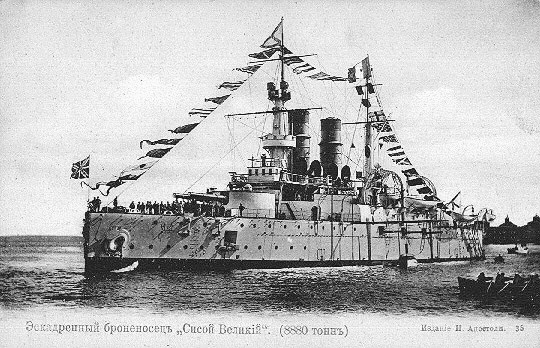
Sissoi Veliky
Her main belt was 227 feets long, 7 feets wide, 14 inches on the waterline with 6 to 8 inches on the lower edge. Bulkhead were made in compound steel, not Harvey, 5 to 9in while the 5 in upper belt was 150 feets by 7,5 feets. The armour deck was 2 in over the main belt, 3 in at the ends, and the turret crowns were 2,5 in. She has 12 boilers, 2 shafts and a VTE engine for 8700 ihp (200 more than Sissoi), for 15.6 knots, so even slower than her sister ship.
The Sissoi Veliky in action
This ship experienced a sever accident in 1897, so just one year after its acceptance in service. A 12 in gun fired while the breech has not been properly closed. All the crew did as a result. She spent some time in exercises, and was eventually part of the fleet that met the Japanese at Tsushima in 1905. She was badly damaged by gunfire, hit by a torpedo right aft, but survived. However, as she was to be surrendered to the Japanese officers valves were opened, and the ship flooded and sank.
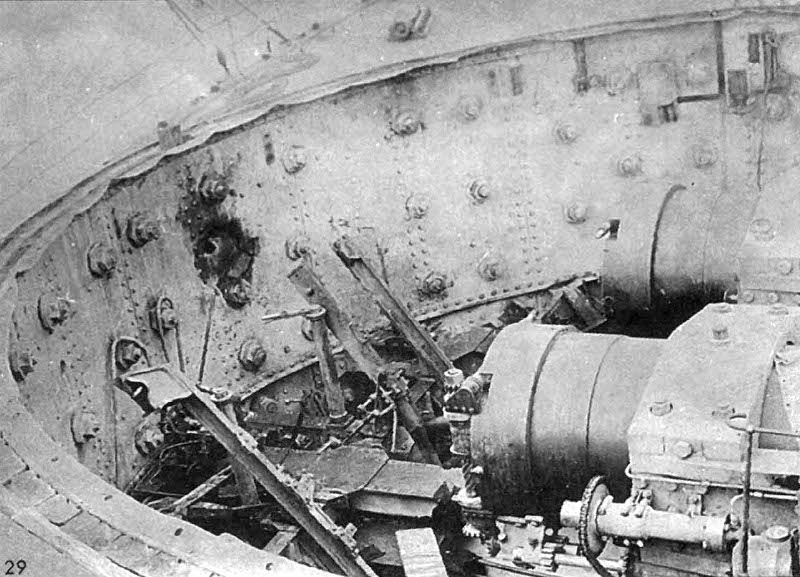
Turret explosion damage in the Sissoi Veliky
The Rostislav first life
Captain Grand Duke Alexander Mikhailovich assumed command of the ship in 1898, the first Romanov to do so. The ship served as an ambassador in Istanbul and also transported other high profiles of the Imperial family, therefore Shipyards and contractors treated Rostislav with utter priority and care. The ship had its rudder frame reinforced and installation of a backup control post deep under the conning tower.
The Rostislav served as the junior flagship of the Black Sea Fleet until September 1912. Exercisez showed its high coal consumption and revealing smoke panache, severe local overheating, buckling of fireboxes and sudden backdrafts which necessitated repairs and alterations, which weighted the ship so much that its main defensive belt was sunk below the waterline. In 1905 her crew was on the verge of open mutiny, while being ordered to deal with Potemkine’s mutineers, even destroy the rebels by force. The captains refrained to do so. But that occurred at the time of the Ochakov mutiny in November 1905. In 1907 there was a plan to remove elements up to 250 tons to help the ship’s overweight problem, but this was cancelled because of funds shortages.
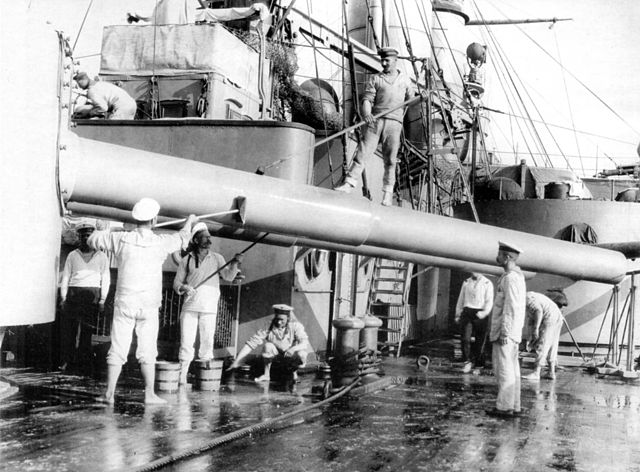
Rostislav’s main guns being cleaned.
The Rostislav in the Great War
By 1914 she was of questionable military value, despite the removal of a dozen of her 37 mm guns and addition of a modern rangefinder, probably made by Barr and Stroud in 1908. She was versed into the reserve in August 1914. Still, she was an important part of the Black Sea fleet, and as such was engaged intensively in operations, notably to compensate for the absence of other more modern battleships. Between two sorties, her armament was changed considerably: The Torpedo-tubes and tertiary artillery were taken out for the benefit of four 75 mm AA pieces. In 1917 she was engaged against the Yavuz (ex-Goeben) and bombarded Turkish coastal installations.
Revolution and aftermath
Like other ships in Sevastopol, her career was turbulent: In April 1918, she passed under Ukrainian control and flag. She was then captured by the Germans when they advanced, and then by the British after the German capitulation. She the was partially made unusable by the sabotage of its machines in April 1919 to prevent capture by the Bolsheviks. She was eventually recaptured by the white Russians supported by the allies during the Crimean offensive, and used as coastal battery, but finally scuttled the 16 November 1920 in Kerch.
Specifications (Rostislav) |
|
| Dimensions (L-w-h) | 107.23 x 20.73 x 6.71 m 351’1”x68′ x22′ |
| Total weight, fully loaded | 8,880 tons as designed |
| Armament | 2×2 254 mm (12 in), 8 x152 mm (6 in) 20x 47 mm (3pdr), 16x 37 mm (1pdr), 6 457 mm (18 in) Torpedo tubes, 4 above waterline, 2 submarines |
| Armor |
Belt: 5–14 in (203–356 mm) Turrets: 10 in (280 mm) Barbettes: 5 in (127 mm) Conning tower: 6 in (152 mm) |
| Crew | 650 |
| Propulsion | 2 shafts, 2 VTE engines, 12 boilers, 8,700 ihp |
| Speed (road) | 15.6 knots (28 km/h; 14 mph) |
Links, sources
Rostislav on Wikipedia
Sissoi Veliky on wikipedia
Conways all the world’s fighting ships 1860-1905
Gallery
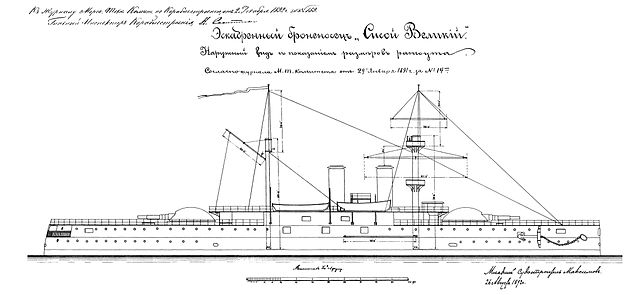


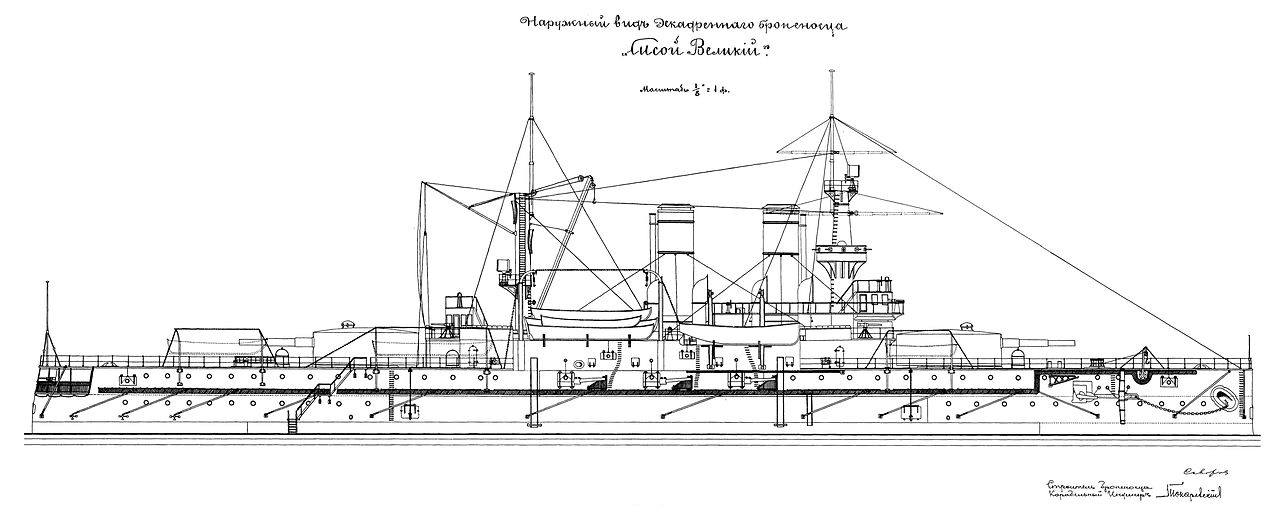

 Latest Facebook Entry -
Latest Facebook Entry -  X(Tweeter) Naval Encyclopedia's deck archive
X(Tweeter) Naval Encyclopedia's deck archive Instagram (@navalencyc)
Instagram (@navalencyc)





 French Navy
French Navy Royal Navy
Royal Navy Russian Navy
Russian Navy Armada Espanola
Armada Espanola Austrian Navy
Austrian Navy K.u.K. Kriegsmarine
K.u.K. Kriegsmarine Dansk Marine
Dansk Marine Nautiko Hellenon
Nautiko Hellenon Koninklije Marine 1870
Koninklije Marine 1870 Marinha do Brasil
Marinha do Brasil Osmanlı Donanması
Osmanlı Donanması Marina Do Peru
Marina Do Peru Marinha do Portugal
Marinha do Portugal Regia Marina 1870
Regia Marina 1870 Nihhon Kaigun 1870
Nihhon Kaigun 1870 Preußische Marine 1870
Preußische Marine 1870 Russkiy Flot 1870
Russkiy Flot 1870 Svenska marinen
Svenska marinen Søværnet
Søværnet Union Navy
Union Navy Confederate Navy
Confederate Navy Armada de Argentina
Armada de Argentina Imperial Chinese Navy
Imperial Chinese Navy Marinha do Portugal
Marinha do Portugal Mexico
Mexico Kaiserliche Marine
Kaiserliche Marine 1898 US Navy
1898 US Navy Sovietskiy Flot
Sovietskiy Flot Royal Canadian Navy
Royal Canadian Navy Royal Australian Navy
Royal Australian Navy RNZN Fleet
RNZN Fleet Chinese Navy 1937
Chinese Navy 1937 Kriegsmarine
Kriegsmarine Chilean Navy
Chilean Navy Danish Navy
Danish Navy Finnish Navy
Finnish Navy Hellenic Navy
Hellenic Navy Polish Navy
Polish Navy Romanian Navy
Romanian Navy Turkish Navy
Turkish Navy Royal Yugoslav Navy
Royal Yugoslav Navy Royal Thai Navy
Royal Thai Navy Minor Navies
Minor Navies Albania
Albania Austria
Austria Belgium
Belgium Columbia
Columbia Costa Rica
Costa Rica Cuba
Cuba Czechoslovakia
Czechoslovakia Dominican Republic
Dominican Republic Haiti
Haiti Hungary
Hungary Honduras
Honduras Estonia
Estonia Iceland
Iceland Eire
Eire Equador
Equador Iran
Iran Iraq
Iraq Latvia
Latvia Liberia
Liberia Lithuania
Lithuania Mandchukuo
Mandchukuo Morocco
Morocco Nicaragua
Nicaragua Persia
Persia San Salvador
San Salvador Sarawak
Sarawak Uruguay
Uruguay Venezuela
Venezuela Zanzibar
Zanzibar Warsaw Pact Navies
Warsaw Pact Navies Bulgaria
Bulgaria Hungary
Hungary

 Bundesmarine
Bundesmarine Dutch Navy
Dutch Navy Hellenic Navy
Hellenic Navy Marina Militare
Marina Militare Yugoslav Navy
Yugoslav Navy Chinese Navy
Chinese Navy Indian Navy
Indian Navy Indonesian Navy
Indonesian Navy JMSDF
JMSDF North Korean Navy
North Korean Navy Pakistani Navy
Pakistani Navy Philippines Navy
Philippines Navy ROKN
ROKN Rep. of Singapore Navy
Rep. of Singapore Navy Taiwanese Navy
Taiwanese Navy IDF Navy
IDF Navy Saudi Navy
Saudi Navy Royal New Zealand Navy
Royal New Zealand Navy Egyptian Navy
Egyptian Navy South African Navy
South African Navy






























 Ukrainian Navy
Ukrainian Navy dbodesign
dbodesign